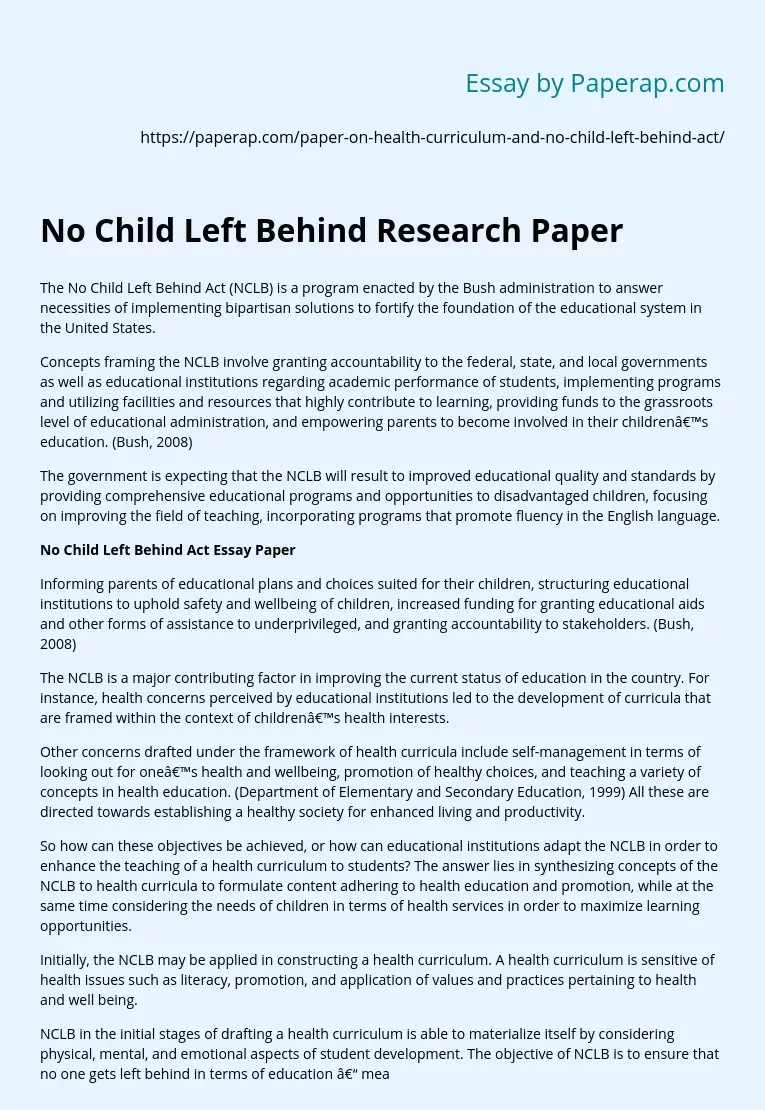No Child Left Behind Research Paper
The No Child Left Behind Act (NCLB) is a program enacted by the Bush administration to answer necessities of implementing bipartisan solutions to fortify the foundation of the educational system in the United States.
Concepts framing the NCLB involve granting accountability to the federal, state, and local governments as well as educational institutions regarding academic performance of students, implementing programs and utilizing facilities and resources that highly contribute to learning, providing funds to the grassroots level of educational administration, and empowering parents to become involved in their children’s education.
(Bush, 2008)
The government is expecting that the NCLB will result to improved educational quality and standards by providing comprehensive educational programs and opportunities to disadvantaged children, focusing on improving the field of teaching, incorporating programs that promote fluency in the English language.
No Child Left Behind Act Essay Paper
Informing parents of educational plans and choices suited for their children, structuring educational institutions to uphold safety and wellbeing of children, increased funding for granting educational aids and other forms of assistance to underprivileged, and granting accountability to stakeholders.
(Bush, 2008)
The NCLB is a major contributing factor in improving the current status of education in the country. For instance, health concerns perceived by educational institutions led to the development of curricula that are framed within the context of children’s health interests.
Other concerns drafted under the framework of health curricula include self-management in terms of looking out for one’s health and wellbeing, promotion of healthy choices, and teaching a variety of concepts in health education.
(Department of Elementary and Secondary Education, 1999) All these are directed towards establishing a healthy society for enhanced living and productivity.
So how can these objectives be achieved, or how can educational institutions adapt the NCLB in order to enhance the teaching of a health curriculum to students? The answer lies in synthesizing concepts of the NCLB to health curricula to formulate content adhering to health education and promotion, while at the same time considering the needs of children in terms of health services in order to maximize learning opportunities.
Initially, the NCLB may be applied in constructing a health curriculum. A health curriculum is sensitive of health issues such as literacy, promotion, and application of values and practices pertaining to health and well being.
NCLB in the initial stages of drafting a health curriculum is able to materialize itself by considering physical, mental, and emotional aspects of student development. The objective of NCLB is to ensure that no one gets left behind in terms of education – meaning, that all students are able to acquire necessary education within their levels. With this in mind, initial considerations should include the background of the students.
To fully realize the concept of NCLB under the context of health curriculum, the curriculum itself should be designed such that the students will be able to accomplish learning objectives under it. The health curriculum should be designed such that it is sensitive to the learning needs and individual differences of the students.
In addressing this primary concern, programs and activities under the health curriculum will ensure that all students will be able to grasp specific concepts within their own learning skills and capabilities as learners.
Generally, the preparedness of students is being identified in all three aspects – the physical, emotional, and mental learning needs. Considering physical needs involve asking questions such as, “are students prepared to carry out physical activities demanded by the health curriculum?” This includes monitoring physical skills and abilities in order to structure attainable and realistic kinesthetic health activities.
Emotional needs include the learners’ capacity to accept and give value to health concepts as they are revealed to them. One very sensitive issue when it comes to health literacy is the concept of puberty and gender differences. In this case, teachers should gauge whether learners are ready to confront these personal and perceptive issues during the learning process.
Learning needs pertaining to mental capacity involves questioning the ability of students to comprehend health concepts. Teachers should ask themselves whether students are already able to give meaning and interpret health concepts as they are. (Lewallan, 2004)
Aside from considering these learning needs, teachers should also address individual differences. The rate of growth and development for each learner differs. There are fast learners and late bloomers. Some learners might be skilled in physical activities but weak in mental exercises. To address these concerns, application of the NCLB in a health curriculum is needed in order to formulate a flexible curriculum that appropriate to the learning styles and individual differences of the learners.
To prove contrast, if a health curriculum is strictly standardized, aiming at a singular learning objective through same levels of learning activities and programs, say for instance practical health examinations, only those skilled physically will be able to experience success and accomplish learning objectives.
How about students who are not skilled in physical examinations but exhibit excellence in mental activities? Health curricula drafted under the NCLB should be flexible to individual differences, varying learning styles, and learning needs. (Lewallan, 2004)
Works Cited
Bush, G. W. (2008). “Foreword by President George W. Bush.” Retrieved from The White
House. 09 Sep 2008. http://www.whitehouse.gov/news/reports/no-child-left-behind.html
Department of Elementary and Secondary Education. (1999). “Massachusetts Comprehensive
Health Curriculum Framework – October 1999.” Retrieved September 9, 2008, from Massachusetts Department of Elementary and Secondary Education. Website: http://www.doe.mass.edu/frameworks/health/1999/core.html
No Child Left Behind Research Paper. (2019, Dec 05). Retrieved from https://paperap.com/paper-on-health-curriculum-and-no-child-left-behind-act/

